Mouse Settings Tutorial in Windows 10
Mouse Settings Tutorial in Windows 10 :Most people who work with a computer or laptop prefer to use a mouse. Mice can be used in two modes: wireless and wired. Wireless mice can be connected to your system via Bluetooth or a USB dongle. Even if you use a laptop, if you don’t use a mouse, you have a touchpad to guide the mouse pointer. Although you can start using the Mouse as soon as you connect it with a wire or wireless connection or the laptop’s touchpad, it is always convenient to apply mouse settings based on your tastes and desires.
Many mouse settings in Windows 10 can help you customize your Mouse’s performance. For example, you can change the cursor speed, swap the left and right mouse buttons, or change the pointer’s appearance to your liking. In the rest of this article, we will introduce all the mouse settings in Windows 10 through Windows Settings and Control Panel.
Main Mouse Settings Options in Windows 10
Windows 10 Settings provides quick access to some of the most common mouse settings. Open the Start menu and select Settings > Devices. Then, choose Mouse in the left sidebar.
Select your primary button: By default, the primary mouse button is the left button. This option allows you to change it to the right. If you are left-handed or prefer to use the Mouse with your left hand, this is the first option you may want to change.
Cursor speed: Drag the slider left or right to set the speed of the mouse cursor. The left side indicates a slower speed, and the further to the right the cursor moves, the faster it moves. If you notice that the Mouse moves slowly across the screen when you move it, change the speed until you reach the ideal speed.
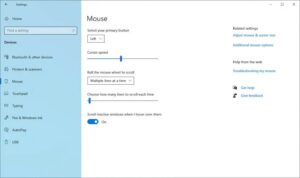
Roll the mouse wheel to scroll: Set the mouse scroll to scroll multiple lines or the entire page at once. The latter is faster but can be annoying at times.
Choose how many lines to scroll each time: If you choose multiple lines, drag the bar below to specify the exact number.
Scroll inactive windows when I hover over them: Determine whether you want to scroll the contents of any window when you hover over them. If you multitask with multiple windows, you can leave this option enabled. Conversely, to prevent accidental scrolling of inactive windows, turn it off.
Ease of Access options in Mouse settings
Windows 10 includes a few mouse-related settings in the Ease of Access section. To access them, go to Settings > Ease of Access.
The first setting option under Mouse Pointer is in the left sidebar.

Change pointer size and color.
Change pointer size
Drag the slider to increase or decrease the size of the pointer to the ideal size.
Change pointer color
You can change the color of the pointer here by choosing from predefined colors or creating your own. For example, you can change the default white pointer to black, change the colors based on the background, or choose a color.
The second section of mouse settings in the Ease of Access section is in the left sidebar, under the heading Text cursor.

Turn on text cursor indicator: Enabling the text cursor improves visibility while typing. After enabling this option, select a color and use the bar below to make the cursor bold or light.
Change the thickness of the text cursor: Here, you can drag the bar to increase or decrease the thickness of the text cursor.
Accessing the Mouse Properties page
The Mouse Properties section in Windows 10 contains various categories of mouse settings. You can access it by selecting Additional mouse options in Settings > Devices > Mouse > Related settings.
Mouse Properties is a legacy dialog box comprising five tabs: Buttons, Pointers, Pointer Options, Wheel, and Hardware. Some of these tabs have settings similar to the Windows settings we’ve learned so far. Below, we’ll walk you through each section in detail.
Mouse Properties: Buttons
As the name suggests, the Buttons tab on the Mouse Properties page focuses on how the mouse buttons work.
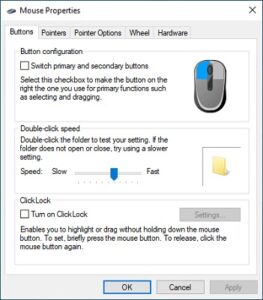
Button configuration: You can change the default left and right buttons here.
Double-click speed: Use the bar to set the double-click speed. If you have trouble opening files and folders, try slowing down the speed.
Enable ClickLock: This option allows you to drag files and folders without clicking and holding them. Instead, hold down the button briefly to start selecting an item (select Settings to set the duration). Then, move the cursor and select the main button again to release the item.
Mouse Features: Pointers
The Pointers tab is designed to change the mouse pointer’s visual appearance. You can customize some items and also use settings to improve visibility.
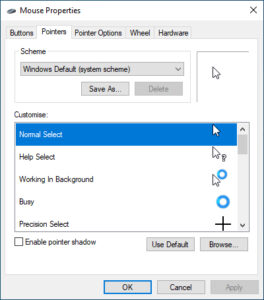
Scheme: Change the default Windows mouse pointer by choosing alternatives such as Windows Black, Windows Inverted, Windows Standard, etc. Before applying, select the scheme that suits you best before using the preview screen.
Customize: Customize the text cursors for each scheme. Double-click on a function (Working in Background, Busy, Text Select, etc.) and select a different ANI or CUR file from the built-in library or a third-party icon pack. If you’re not satisfied, you can always choose the Use Default option to revert any changes to the original settings. So feel free to experiment.
Enable pointer shadow: This option adds a shadow to the mouse pointer, making it a little easier to track as you move the cursor.
Mouse Properties: Pointer Options
The Pointer Options tab on the Mouse Properties page provides additional customization options.
Motion – Select a pointer speed: Set the pointer’s speed on the bar.
Motion – Enhance pointer precision: Enable this option if you prefer mouse acceleration in Windows 10. Contrary to its name, it makes your cursor action more precise!
Snap to: Automatically places the cursor on the default buttons. Turn this off if you prefer complete control over the Mouse.
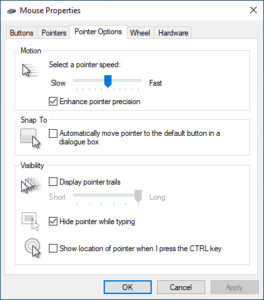
Vertical Scrolling: To scroll a specific number of lines, select the number in the button next to it. Or, if you want to scroll the entire page at once, select the One Page option.
Horizontal Scrolling: If your mouse scroll wheel has a tilt function, enter a number to specify the number of lines you want to scroll horizontally.
Mouse Properties: Hardware
The Hardware section lists all mice and other pointing devices connected to your computer. Select a device and select Properties to view general and driver information about the device.
Mouse Settings Tutorial in Windows
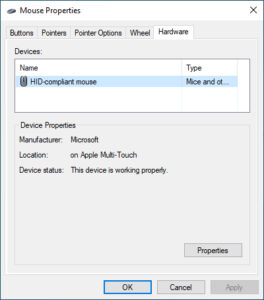
If you’re having trouble using your Mouse, visit this page to update the driver, roll back, disable and re-enable the device, and more. You can also repair your Mouse through Device Manager.
More Accessibility Settings in the Control Panel
Apart from the options above, Windows 10 also includes a set of additional mouse settings that are geared towards accessibility. You can access them by opening the Control Panel and selecting Ease of Access > Change how your Mouse works.
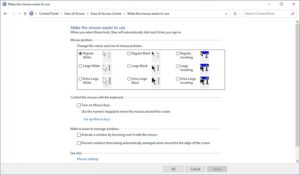
Mouse pointers: You can change the color and size of the mouse pointer here. (This feature overlaps with the color schemes in the Pointers section of the Mouse properties page and the Ease of Access section in Settings).
Mouse control from the keyboard: Check. Turn on the Mouse keys to control the mouse pointer with the keyboard. This is useful for interacting with the pointer when troubleshooting a mouse device.
Make managing windows easier: This includes a few options that allow you to activate windows by hovering over them and prevent windows from automatically adjusting when you move them to the edge of the screen.